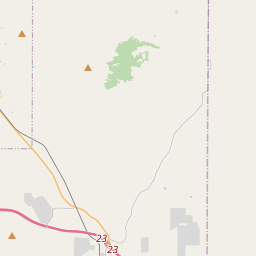"Death of the Bismarck Trail"
Historical marker location:
19881 130th Ave, Vale, South Dakota
( Marker is on 130th Avenue (South Dakota Route 79) ¼ mile north of 199th Street, on the right when traveling north.)
Marker installed: 1954






© OpenStreetMap contributors
South Dakota is the only state in the U.S. that has never had an earthquake.
About Meade County
Meade County Timeline
Meade County, South Dakota, has a rich and diverse history that spans centuries. The region was originally home to several Native American tribes, including the Lakota Sioux, who inhabited the area for thousands of years before European settlement. In the early 1800s, French trappers and traders began to explore the region, establishing trade relationships with the Native American groups.
In the mid-1800s, the discovery of gold in the Black Hills brought a significant influx of settlers to the area. This led to conflicts between Native American tribes and the newly arrived miners, as well as with the U.S. government. The famous Battle of Little Bighorn in 1876 took place in Meade County, where Lakota Sioux leader Sitting Bull and his warriors defeated General George Custer's 7th Cavalry.
Despite these conflicts, the area developed rapidly, with towns springing up to support mining and the railroad industry. Meade County was officially established in 1889 and named after General George Meade, a Union officer in the American Civil War. The county seat, Sturgis, became a vital hub for the region, with its economy largely driven by agriculture, mining, and the nearby military presence at Fort Meade.
Throughout the 20th century, Meade County continued to evolve. Sturgis became internationally renowned for its annual motorcycle rally, which began in 1938 and draws motorcycle enthusiasts from around the world. The county also played a significant role during World War II, as Fort Meade served as a training ground for thousands of soldiers. Today, Meade County is a thriving area with a mix of industries, including agriculture, commerce, and tourism, while still honoring its rich heritage and natural beauty.
In the mid-1800s, the discovery of gold in the Black Hills brought a significant influx of settlers to the area. This led to conflicts between Native American tribes and the newly arrived miners, as well as with the U.S. government. The famous Battle of Little Bighorn in 1876 took place in Meade County, where Lakota Sioux leader Sitting Bull and his warriors defeated General George Custer's 7th Cavalry.
Despite these conflicts, the area developed rapidly, with towns springing up to support mining and the railroad industry. Meade County was officially established in 1889 and named after General George Meade, a Union officer in the American Civil War. The county seat, Sturgis, became a vital hub for the region, with its economy largely driven by agriculture, mining, and the nearby military presence at Fort Meade.
Throughout the 20th century, Meade County continued to evolve. Sturgis became internationally renowned for its annual motorcycle rally, which began in 1938 and draws motorcycle enthusiasts from around the world. The county also played a significant role during World War II, as Fort Meade served as a training ground for thousands of soldiers. Today, Meade County is a thriving area with a mix of industries, including agriculture, commerce, and tourism, while still honoring its rich heritage and natural beauty.
Meade County Timeline
This timeline provides a glimpse into the major events and milestones that have shaped the history of Meade County, South Dakota.
- 1873 - Meade County, SD is established
- 1876 - The Battle of Little Bighorn takes place within Meade County
- 1878 - The town of Sturgis is founded
- 1888 - The Chicago, Burlington and Quincy Railroad reaches Sturgis
- 1890 - The Homestake Mine, one of the largest gold mines in the United States, begins operation
- 1899 - The town of Faith is founded
- 1936 - The Sturgis Motorcycle Rally is first held
- 1964 - Mount Rushmore National Memorial expands into Meade County
- 2010 - The population of Meade County surpasses 25,000